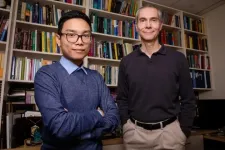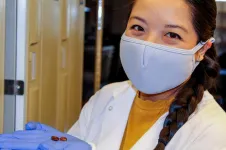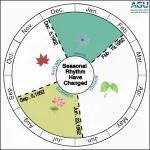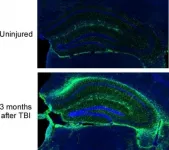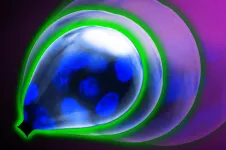(Press-News.org) CHAMPAIGN, Ill. -- Tiny fluorescent semiconductor dots, called quantum dots, are useful in a variety of health and electronic technologies but are made of toxic, expensive metals. Nontoxic and economic carbon-based dots are easy to produce, but they emit less light. A new study that uses ultrafast nanometric imaging found good and bad emitters among populations of carbon dots. This observation suggests that by selecting only super-emitters, carbon nanodots can be purified to replace toxic metal quantum dots in many applications, the researchers said.
The findings, published in the Proceedings of the National Academy of Sciences, brought together researchers from the University of Illinois Urbana-Champaign and the University of Delaware, Baltimore County in a collaborative project through the Beckman Institute for Advanced Science and Technology at Illinois.
"Coming into this study, we did not know if all carbon dots are only mediocre emitters or if some were perfect and others were bad," said Illinois chemistry professor Martin Gruebele, who led the study. "We knew that if we could show that there are good ones and bad ones, maybe we could eventually find a way to pick the perfect ones out of the mix."
Determining whether carbon dots are good or bad light emitters starts with being able to see them, Gruebele said. The dots are less than 10 nanometers in diameter and, when excited, decide whether to fluoresce in a matter of in picoseconds - or one-thousandth of one billionth of a second.
"Using our previously developed single-molecule absorption scanning tunneling microscope, we could only image excited states with no time resolution," Gruebele said. "In this study, however, we can now record quantum dots while in their excited state by combining true nanometer space resolution with femtosecond time resolution."
The team found that the energy excitation takes one of two paths: either emit light or expel the energy as heat before getting a chance to fluorescence.
"We found that in bulk populations, approximately 20% of a given population of carbon nanodots are perfect emitters, while about 80% have a very short light emission state before expelling heat," Gruebele said. "Being able to see that there are different populations tells us that it may be possible to purify carbon dot populations by selecting only the perfect light emitters."
The ability to pick out the perfect dots could make the concept of efficient carbon-based dots a reality, Gruebele said. "Metal quantum dots are often used to monitor the health of living cells, which is far from ideal, and having a nontoxic, economical option would be a significant advancement."
The new imaging technology also allows the researchers to observe why some dots never light up, hinting that there is hope that researchers can someday synthesize perfect light-emitting carbon dots.
"We now know that we have an instrument that identifies the problem," Gruebele said. "Whether we use it to purify groups of carbon dots or to help synthesize perfect light-emitting carbon dots is now just a question of where we want to head next."
INFORMATION:
The James R. Eiszner Chair in Chemistry, the department of chemistry at Illinois, the National Institute of Biomedical Imaging and Bioengineering, and the National Heart, Lung, and Blood Institute supported this study.
Gruebele is also affiliated with the department of physics, the Center for Advanced Study, the Beckman Institute and the Carle Illinois College of Medicine at Illinois.
Editor's notes:
To reach Martin Gruebele, call 217-333-1624; email mgruebel@illinois.edu.
The paper "Ultrafast nanometric imaging of energy flow within and between
single carbon dots" is available from the U. of I. News Bureau
About one billion people worldwide are at risk for schistosomiasis -- a debilitating disease caused by parasitic worms that live in fresh water and in intermediate snail hosts. A new study finds that the transmission risk for schistosomiasis peaks when water warms to 21.7 degrees centigrade, and that the most effective interventions should include snail removal measures implemented when the temperature is below that risk threshold.
The Proceedings of the National Academy of Sciences published the results, led by Emory University, the University of South Florida and the ...
When it comes to microelectronics, there is one chemical element like no other: silicon, the workhorse of the transistor technology that drives our information society. The countless electronic devices we use in everyday life are a testament to how today very high volumes of silicon-based components can be produced at very low cost. It seems natural, then, to use silicon also in other areas where the properties of semiconductors -- as silicon is one -- are exploited technologically, and to explore ways to integrate different functionalities. Of particular interest in this ...
Determining how rapidly the universe is expanding is key to understanding our cosmic fate, but with more precise data has come a conundrum: Estimates based on measurements within our local universe don't agree with extrapolations from the era shortly after the Big Bang 13.8 billion years ago.
A new estimate of the local expansion rate -- the Hubble constant, or H0 (H-naught) -- reinforces that discrepancy.
Using a relatively new and potentially more precise technique for measuring cosmic distances, which employs the average stellar brightness within giant elliptical galaxies as a rung on the distance ladder, astronomers calculate a rate -- 73.3 kilometers per second per megaparsec, give or take 2.5 km/sec/Mpc -- that lies in the middle of three ...
Inflammation in the body has been linked to the intensity of tobacco smoking among people with HIV, according to a team of University of Massachusetts Amherst researchers.
Krishna Poudel, associate professor of community health education in the School of Public Health and Health Sciences, and colleagues reported positive linear relationships between intensity, duration and pack-years of smoking and inflammation in HIV-positive people. They believe it to be the first, more thorough examination of specific smoking-related variables with the levels of inflammation in this group, while also taking into account highly active antiretroviral therapy (HAART) and other important factors.
The study's findings ...
WASHINGTON--Without efforts to mitigate climate change, summers spanning nearly six months may become the new normal by 2100 in the Northern Hemisphere, according to a new study. The change would likely have far-reaching impacts on agriculture, human health and the environment, according to the study authors.
In the 1950s in the Northern Hemisphere, the four seasons arrived in a predictable and fairly even pattern. But climate change is now driving dramatic and irregular changes to the length and start dates of the seasons, which may become more extreme in the future under a business-as-usual climate scenario.
"Summers are getting longer and hotter while winters shorter and warmer ...
Nursing homes with the largest proportions of non-White residents experience 3.3 times more COVID-19 deaths than do nursing homes with the largest proportions of White residents, according to a new study from the University of Chicago. The paper, published in JAMA Network Open, suggests that these differences are likely due to nursing home size and the level of coronavirus spread in the local community, reinforcing the inseparability of long-term care facilities from society at large when it comes to bringing the COVID-19 pandemic to heel.
Since the start of the ...
Traumatic brain injury (TBI) is a major cause of disability and a risk factor for early-onset dementia. The injury is characterized by a physical insult followed acutely by complement driven neuroinflammation. Complement, a part of the innate immune system that functions both in the brain and throughout the body, enhances the body's ability to fight pathogens, promote inflammation and clear damaged cells. Complement plays a role in the brain, regardless of infection or injury, as it influences brain development and synapse formation. In TBI, complement- induced inflammation partially determines the outcome in the weeks immediately following injury. However, more research is needed to define a role for the complement system in neurodegeneration ...
For cancer cells to metastasize, they must first break free of a tumor's own defenses. Most tumors are sheathed in a protective "basement" membrane -- a thin, pliable film that holds cancer cells in place as they grow and divide. Before spreading to other parts of the body, the cells must breach the basement membrane, a material that itself has been tricky for scientists to characterize.
Now MIT engineers have probed the basement membrane of breast cancer tumors and found that the seemingly delicate coating is as tough as plastic wrap, yet surprisingly elastic like a party balloon, able to inflate to twice its original size.
But while a balloon becomes much easier to blow up after some initial effort, the team found that a basement membrane becomes stiffer as it expands. ...
Found around the world, powdery mildew is a fungal disease especially harmful to plants within the sunflower family. Like most invasive pathogens, powdery mildew is understudied and learning how it affects hosts can help growers make more informed decisions and protect their crops.
Scientists at the University of Washington and the University of Central Florida inoculated 126 species of plants in the sunflower family with powdery mildew, growing 500 plants from seeds that were collected from the wild and provided from the USDA germplasm network. Through this ...
BOSTON - The higher rates of obesity in Black, Indigenous and People of Color (BIPOC) compared with other groups in the United States can be attributed in large part to systemic racism, according to a new perspective article published in the Journal of Internal Medicine. The authors offer a 10-point strategy to study and solve the public health issues responsible for this disparity.
"First, it is important to recognize that the interplay of obesity and racism is real. Once persons recognize this, they can begin to appropriately address and treat obesity in BIPOC communities," says co-author Fatima Cody ...
